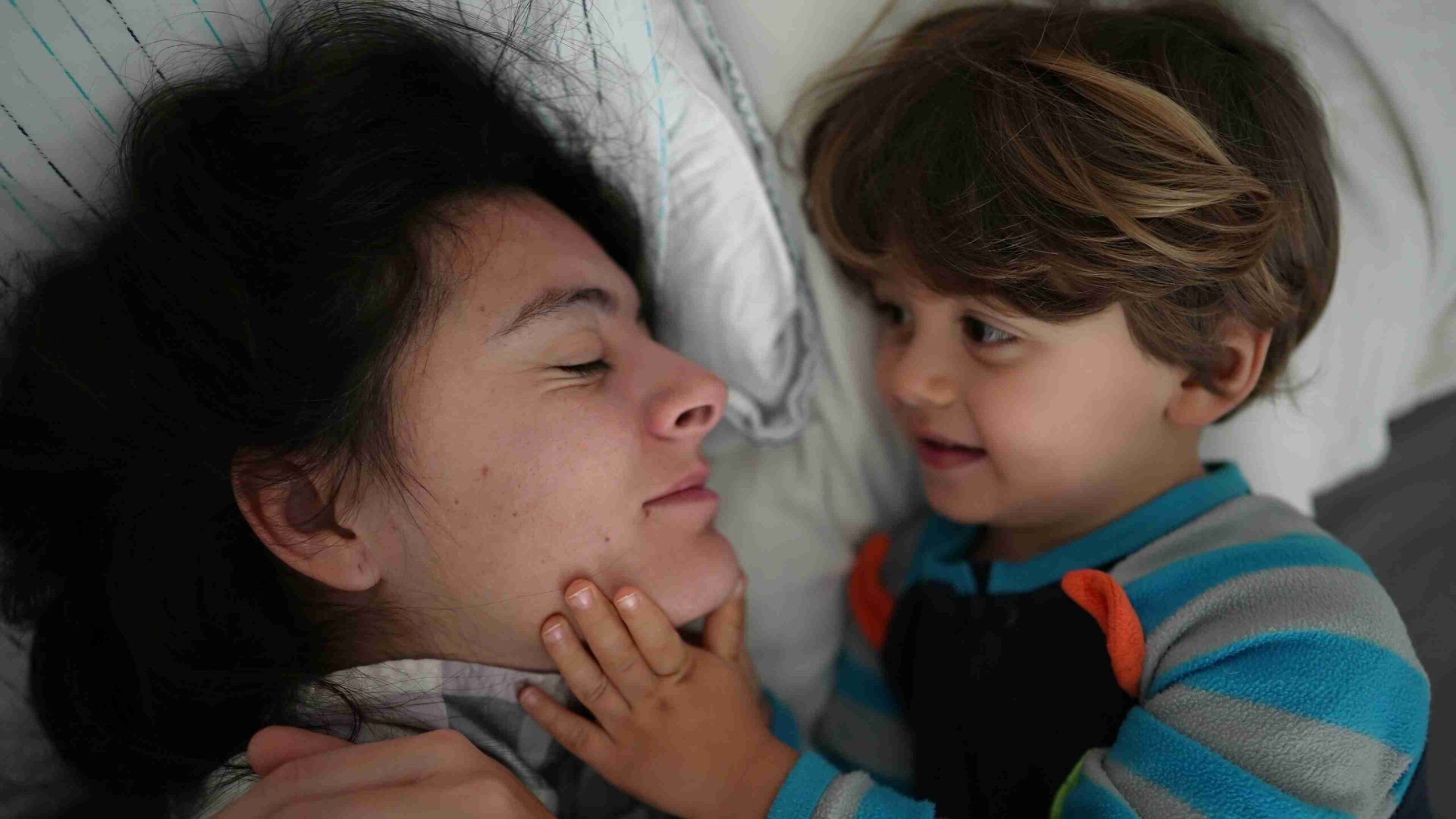For many parents, their toddler’s nap time is a welcome break in the day—a peaceful period when they can do what they need to do—chores, catching up on emails, or maybe taking a nap themselves. But what happens when toddlers show signs they’re ready to stop napping?
Naps give busy toddlers the rest they need to recharge and process the experiences of their growing world. However, as toddlers grow, the question of “When do toddlers drop their nap?” becomes the next challenge to tackle.
Transitioning from daily naps to a no-nap routine is a natural part of development, but understanding how to adjust routines can make this shift smoother for everyone involved. Of course, every child is unique, and nap needs vary widely, so following your toddler’s natural cues rather than a strict schedule is essential.
In this blog, we’ll explore the signs that your toddler may be ready and share tips for navigating this transition while keeping daily routines consistent and balanced.
When Do Toddlers Typically Stop Napping?
The age at which toddlers stop napping varies widely. While some children may be ready to give up naps as early as two years old, others may continue needing daytime sleep until kindergarten.
Several factors influence when toddlers stop napping, including developmental milestones, individual sleep patterns, and daily activity levels. Here are some key points that can impact when a child is ready to drop naps.
Age and Developmental Milestones
As toddlers grow, they tend to stay active and engaged longer without requiring a nap. Their physical, social, and cognitive development can all contribute to changes in sleep needs.
Individual Sleep Needs
Every child has unique sleep patterns. While some toddlers seem energized after a 30-minute nap, others may need an hour or more to function optimally.
Lifestyle and Activity Levels
Busy or physically active days might increase a child’s need for naps, while quieter days may make it harder for them to nap.
3 Signs Your Toddler is Ready to Drop Their Nap

At what age do toddlers stop napping? Recognizing the signs that your toddler is ready to stop napping can make the transition to no naps much easier. Here are some of the most common indicators a child might be prepared to reduce or eliminate their daily nap.
1. Consistently Resisting Nap Time
One of the first signs that your toddler may be ready to transition away from naps is consistent resistance. While occasional nap resistance is normal, if your child has difficulty settling down for a nap or regularly protests sleep during nap time, they may need less daytime rest.
2. Staying Awake During Nap Hours
When toddlers are ready to stop napping, they may remain awake during their regular nap time. If your child is content to sit quietly, play independently, or rest without falling asleep, it may be a sign they are getting enough sleep at night.
3. Remaining Energetic After a Nap
Another clear sign that a toddler is ready to drop their nap is if they still have high energy levels after nap time, especially if this energy continues into the evening, making bedtime more challenging. In this case, reducing or eliminating the naps could help regulate their overall sleep pattern.
It’s normal for toddlers to experience nap regressions, especially during illness, travel, or developmental changes. If a child who has recently stopped napping suddenly needs a nap again, this may be temporary. Allowing them to rest as required helps support their comfort and well-being.
10 Practical Tips for Managing a Toddler’s Nap Transition
Transitioning from napping to no naps doesn’t have to be abrupt. Gradual changes and adjustments can make this shift smoother, allowing parents and toddlers to adjust comfortably. Here are some tips for supporting a child through this transition.
- Gradually Shorten Nap Times
If your toddler isn’t ready to skip naps, gradually reduce the nap duration. For example, if they usually nap for 90 minutes, consider cutting it back to 60 minutes, then 45, and so on. Gradually shortening naps allows your child to adjust to less daytime sleep without feeling overtired. - Move Bedtime Earlier
When toddlers stop napping, their bedtime may be slightly earlier to compensate for the lost rest. Consider moving their bedtime up by 15 to 30 minutes to help ensure they’re still getting the total amount of sleep needed for their development and well-being. - Introduce Quiet Time as an Alternative
Replacing nap time with quiet time can provide a much-needed break in the day for both children and parents. Encourage your toddler to rest with a book, play with soft toys, or listen to calming music during quiet time. This period of low activity allows children to recharge and unwind, helping to prevent overtiredness while transitioning away from naps. - Balance Naps with Daily Routines
When eliminating naps, balancing other parts of your toddler’s daily routine, such as mealtimes, playtime, and other activities, is essential. Ensure active play is scheduled earlier to tire them out, while quieter activities are planned in the afternoon. This balance helps toddlers maintain energy levels without becoming overly tired, which can impact their mood and behaviour. - Plan engaging activities earlier in the day
Avoid scheduling high-energy activities too close to bedtime. Physical activities earlier in the day can help them release energy, making it easier to wind down as evening approaches. - Introduce calming afternoon activities
Instead of naps, try reading, quiet games, or low-stimulation activities like drawing or listening to music to help toddlers recharge without a full nap. - Use quiet time as a buffer
On days when your toddler seems too tired, let them rest quietly without the pressure to sleep. This practice helps them adapt while offering the restorative downtime they need. - Observe sleep cues
Pay attention to cues like rubbing eyes, yawning, or crankiness. Adjust the day’s routine based on your child’s needs—whether that means a slightly longer quiet time or an early bedtime. - Incorporate calming pre-bedtime rituals
As your toddler stops napping, the importance of an evening wind-down routine increases. Gentle activities like a warm bath, soft music, or a bedtime story can signal that it’s time to start winding down, helping them settle into a peaceful night’s sleep. - Stay flexible
Remember that nap transitions can take time, and occasional setbacks are normal. If your child seems especially tired one day, don’t hesitate to let them have a short nap or extra quiet time. Gradually, their sleep needs will stabilize and adapt to the new rhythm.
The Importance of Routine During Nap Transitions and Why Consistency Matters

Maintaining a consistent daily routine becomes even more critical as toddlers transition away from naps. Routines give children a sense of security and predictability, which can help reduce stress or frustration during this adjustment. Transitions become smoother for parents and children with a set, predictable time for rest, play, meals, and sleep.
Appropriately scheduling a toddler’s nap times is essential to consistency, which plays a vital role in emotional regulation. The security of knowing what’s next can reduce anxiety and help toddlers feel more in control, especially during changes like dropping naps. Having a routine allows children to adapt to change gradually, knowing that the other parts of their day will remain the same.
At Childventures, we understand the importance of routine in supporting healthy early childhood development. Our programs integrate a structured approach to daily routines, incorporating nap times, quiet times, and learning activities that foster growth, confidence, and well-being. We are committed to helping children adapt to their unique rhythms while providing the nurturing environment they need to thrive.
Supporting Your Child’s Growth with Childventures
If you’re looking for guidance on supporting your child’s changing sleep needs, Childventures is here to help with programs that blend structured routines with flexible activities to help children grow, learn, and adapt.
Naps are essential to the Childventures program, as are Montessori, Core Knowledge, HighScope, and wholesome nutrition programs to offer a comprehensive approach to early childhood education.
Book a tour of your nearest Childventures centre to see how our programs support healthy routines and nurture early development.



